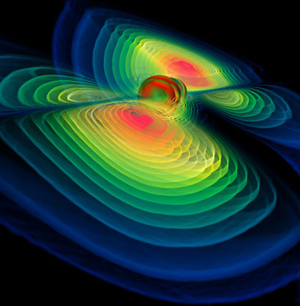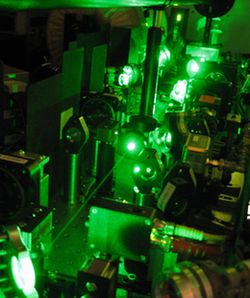Can Light b "Squeezed" to Improve Sensitivity of Gravitation

LIGO was designed by collaborators from MIT and Caltech to search for observational evidence of theoretical gravitational waves. Gravitational waves are thought to propagate throughout the Universe as massive objects disturb space-time. For example, if two black holes collided and merged (or collided and blasted away from each other), Einstein's theory of general relativity predicts that a ripple will be sent throughout the fabric of space-time. To prove gravitational waves do exist, a totally different type of observatory needed to be built, not to observe electromagnetic emissions from the source, but to detect the passage of these perturbations travelling through our planet. LIGO is an attempt to measure these waves, and with a gargantuan set-up cost of $365 million, there is huge pressure for the facility to discover the first gravitational wave and its source (for more information on LIGO, see "Listening" for Gravitational Waves to Track Down Black Holes). Alas, after several years of science, none have been found. Is this because there are no gravitational waves out there? Or is LIGO simply not sensitive enough?
The first question is quickly answered by LIGO scientists: more time is needed to collect a longer period of data (there needs to be more "exposure time" before gravitational waves are detected). There is also strong theoretical reasons why gravitational waves should exist. The second question is something scientists from the US and Australia hope to improve; perhaps LIGO needs a boost in sensitivity.
To make gravitational wave detectors more sensitive, Nergis Mavalvala leader of this new research and MIT physicist, has focused on the very small to help detect the very big. To understand what the researchers are hoping to achieve, a very brief crash course in quantum "fuzziness" is needed.
Detectors such as LIGO depend on highly accurate laser technology to measure perturbations in space-time. As gravitational waves travel through the Universe, they cause tiny changes in the distance between two positions in space (space is effectively being "warped" by these waves). Although LIGO has the ability to detect a perturbation of less than a thousandth of the width of a proton, it would be great if even more sensitivity is acquired. Although lasers are inherently accurate and very sensitive, laser photons are still governed by quantum dynamics. As the laser photons interact with the interferometer, there is a degree of quantum fuzziness meaning the photon is not a sharp pin-point, but slightly blurred by quantum noise. In an effort to reduce this noise, Mavalvala and her team have been able to "squeeze" laser photons.

Laser photons possess two quantities: phase and amplitude. Phase describes the photons position in time and amplitude describes the number of photons in the laser beam. In this quantum world, if the laser amplitude is reduced (removing some of the noise); quantum uncertainties in laser phase will increase (adding some noise). It is this trade-off that this new squeezing technique is base on. What is important is accuracy in the measurement of amplitude, not the phase, when trying to detect a gravitational wave with lasers.
It is hoped that this new technique can be applied to the multi-million dollar LIGO facility, possibly increasing LIGO's sensitivity by 44%.








 California has launched a media blitz about its new law, for example. But it hasn't specifically asked rental car agencies to warn out-of-state renters, says Jan Mendoza, spokeswoman for the California Department of Motor Vehicles. To play it safe, stay off the phone no matter where you are.
California has launched a media blitz about its new law, for example. But it hasn't specifically asked rental car agencies to warn out-of-state renters, says Jan Mendoza, spokeswoman for the California Department of Motor Vehicles. To play it safe, stay off the phone no matter where you are.



